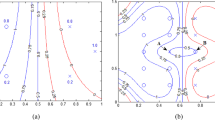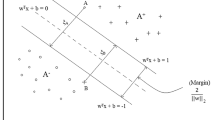Abstract
Fuzzy support vector machine applied a degree of membership to each training point and reformulated the traditional support vector machines, which reduced the effects of noises and outliers for classification. However, the degree of membership only considered the distance from samples to the class center in the sample space, while neglected the situation of samples in the feature space and easily mistook the edge support vectors as noises. To deal with the aforementioned problems, the support vector machine based on intuitionistic fuzzy number and kernel function is proposed. In the high-dimensional feature space, each training point is assigned with a corresponding intuitionistic fuzzy number by the use of kernel function. Then, a new score function of the intuitionistic fuzzy numbers is introduced to measure the contribution of each training point. In the end, the new support vector machine is constructed according to the score value of each training point. The simulation results demonstrate the effectiveness and superiority of the proposed method.





Similar content being viewed by others
References
Atanssov K (1983) Intuitionistic fuzzy sets. VII ITKR’s Session, Sofia
Atanssov K (1986) Intuitionistic fuzzy sets. Fuzzy Sets Syst 20:87–96
Bai P, Zhang XB, Zhang B et al (2008) Support vector machine and its application in mixed gas infrared spectrum analysis. Xidian University Press, Xi’an
Bovolo F, Bruzzone L, Carlin L (2010) A novel technique for subpixel image classification based on support vector machine. IEEE Trans Image Process 19(11):2983–2999
Burges CJC (1998) A tutorial on support vector machines for pattern recognition. Data Mining Knowl Discov 2(2):121–176
Chang CC, Lin CJ (2001) A library for support vector machines. http://www.csie.ntu.edu.tw/ cjlin/libsvm
Deng NY, Tian YJ (2009) Support vector machine theory, algorithms and generalization. Science Press, Beijing
Gao J, Liu ZQ, Shen P (2009) On characterization of credibilistic equilibria of fuzzy-payoff two-player zero-sum game. Soft Comput 13(2):127–132
Gao J, Zhang Q, Shen P (2011) Coalitional game with fuzzy payoffs and credibilistic Shapley value. Iran J Fuzzy Syst 8(4):107–117
Ha MH, Huang S, Wang C et al (2011) Intuitionistic fuzzy support vector machine. J Hebei Univ (Nat Sci Edn) 3:225–229
Lin CF, Wang SD (2002) Fuzzy support vector machines. IEEE Trans Neural Netw 13(2):464–471
Li L, Zhou MM, Lu YL (2009) Fuzzy support vector machine based on density with dual membership. Comput Technol Dev 19(12):44–47
Nello C, John S (2000) An introduction to support vector machines. Cambridge University Press, Cambridge
Ong CJ, Shao SY, Yang JB (2010) An improved algorithm for the solution of the regularization path of support vector machine. IEEE Trans Neural Netw 21(3):451–462
Shen P, Gao J (2011) Coalitional game with fuzzy information and credibilistic core. Soft Comput 15(4):781–786
Vapnik VN (1995) The nature of statistical learning theory. A Wiley-Interscience Publication, New York
Vapnik VN (1998) Statistical learning theory. A Wiley-Interscience Publication, New York
Vapnik VN (1999) An overview of statistical learning theory. IEEE Trans Neural Netw 10(5):988–999
Zadeh LA (1965) Fuzzy sets. Inf Control 8:338–353
Acknowledgments
This work is supported by the National Natural Science Foundation of China (No.60773062, No.61073121), the Natural Science Foundation of Hebei Province of China (No.F2012402037, No.A2012201033, No.F2008000633, No.2010000318).
Author information
Authors and Affiliations
Corresponding author
Rights and permissions
About this article
Cite this article
Ha, M., Wang, C. & Chen, J. The support vector machine based on intuitionistic fuzzy number and kernel function. Soft Comput 17, 635–641 (2013). https://doi.org/10.1007/s00500-012-0937-y
Published:
Issue Date:
DOI: https://doi.org/10.1007/s00500-012-0937-y




